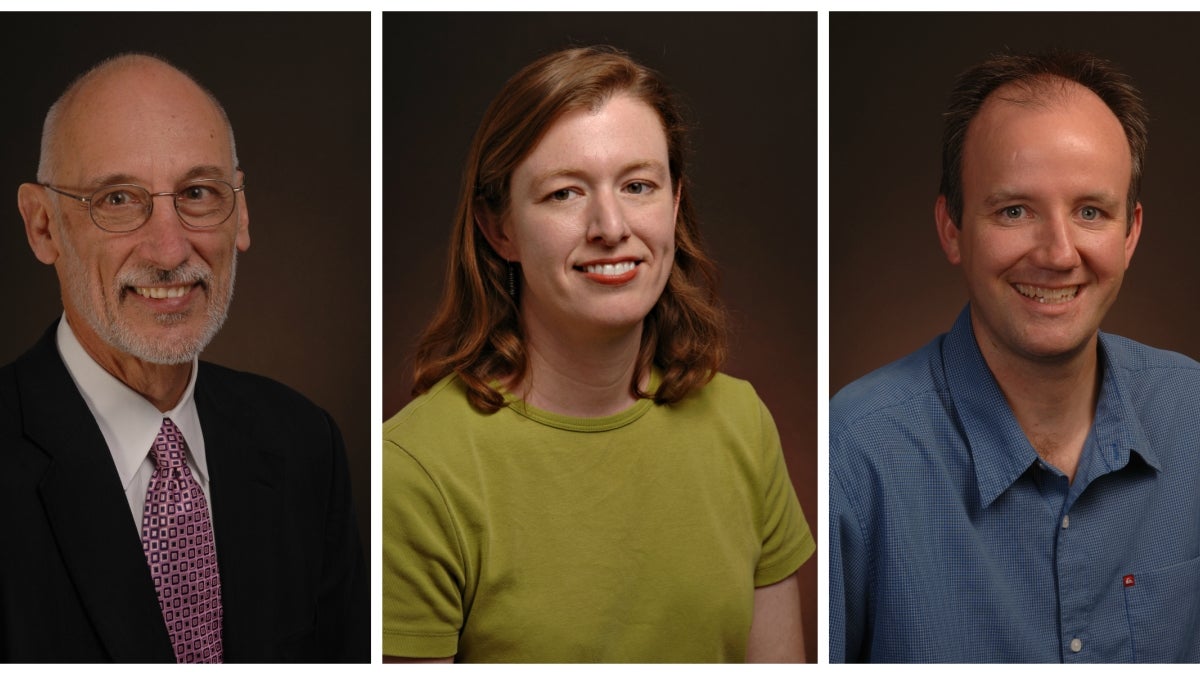3 ASU faculty named Regents' Professors for 2016-2017

New Regents' Professors (from left) Robert Nemanich, Department of Physics; Anne Stone, School of Human Evolution and Social Change; Paul Westerhoff, School of Sustainable Engineering and the Built Environment.
Three Arizona State University faculty have been named Regents’ Professors for the 2016-2017 academic year: Robert Nemanich, Anne Stone and Paul Westerhoff.
Regents’ Professor is the highest faculty honor and is conferred on full professors who have made remarkable achievements that have brought them national and international distinction.
“These new Regents’ Professors are exceptional scholars and pioneering researchers in their field,” says Mark Searle, university provost and executive vice president. “Their unique contributions in genetics, physics and environmental engineering led to them earning this distinction.”
Here’s a look at the professors:
Robert Nemanich, Department of Physics, College of Liberal Arts and Sciences
Professor Nemanich’s groundbreaking research is in a broad range of fields, seldom mastered by a single person. He has made seminal discoveries in diamond and diamond-like materials, optical spectroscopy, III-Nitride materials, novel probe microscopy techniques, and advanced thin film growth methods. These breakthrough techniques have applications in electronic devices, optoelectronics and semiconductors.
A Fellow of the American Physical Society, an honor limited to no more than half of 1 percent of APS membership in any one year, and a Fellow of the Materials Research Society, Nemanich also served as physics department chair at ASU from 2006 to 2013. He also directs the ASU NanoScience Lab, an interdisciplinary group of researchers and students from physics, electrical engineering and materials science.
He has published more than 400 research papers, which have been cited in scientific literature thousands of times. One of his reviewers said, “He is unquestionably one of the two or three world leaders in diamond thin films that has had real technological impact.”
Anne Stone, School of Human Evolution and Social Change, College of Liberal Arts and Sciences
Professor Stone is an anthropological geneticist who has transformed knowledge in forensic science, the genetics of infectious diseases, and the evolutionary history of humans and the great apes. She was a key developer of paleogenetics techniques for extraction of DNA from ancient remains. Her lab verified the first Neanderthal ancient DNA and contributed to information that led to a better understanding of the Tyrolean Iceman (a man frozen in the Alps about 5,000 years ago).
She has published significant work on the genetics of reemerging infectious diseases, especially leprosy and tuberculosis. Her lab showed that tuberculosis likely "jumped" into humans more recently than previously thought and that ancient strains of tuberculosis in South America were introduced by infected seals.
A talented researcher in evolutionary medicine, her publications outside of anthropology journals include Cell, Nature, and Science. She has been a Fulbright Fellow, a Kavli Scholar and Fellow of the American Association for the Advancement of Science. Stone was recently elected by her peers to the prestigious National Academy of Sciences, which includes past and present members such as Jane Buikstra, Margaret Mead, Stephen Hawking and Albert Einstein.
Paul Westerhoff, School of Sustainable Engineering and the Built Environment, Ira A. Fulton Schools of Engineering
Professor Westerhoff has received wide recognition for his work on water treatment and developing novel technologies to address emerging water issues. One of environmental engineering’s most challenging topics is the management of engineered nano-materials in the water environment. Nanomaterials are produced in many consumer products, but their inevitable dissemination into the environment poses risks to the ecosystem and human health.
In addition to publishing more than 180 peer reviewed papers, Westerhoff has received support from the U.S. Environmental Protection Agency for three of its coveted STAR projects. He also has support from the National Science Foundation, National Institutes of Health and the SemiConductor Research Corp. for his research into nanomaterials in the water.
He has served as chair of the Department of Civil and Environmental Engineering at ASU and founding director of ASU’s School of Sustainable Engineering and the Built Environment. The technologies and applications that he has invented to treat drinking water can transform water safety, particularly for the underdeveloped world.
Written by Michele St. George
More Science and technology

Cosmic clues: Metal-poor regions unveil potential method for galaxy growth
For decades, astronomers have analyzed data from space and ground telescopes to learn more about galaxies in the universe.…

Indigenous geneticists build unprecedented research community at ASU
When Krystal Tsosie (Diné) was an undergraduate at Arizona State University, there were no Indigenous faculty she could look to…

Pioneering professor of cultural evolution pens essays for leading academic journals
When Robert Boyd wrote his 1985 book “Culture and the Evolutionary Process,” cultural evolution was not considered a true…